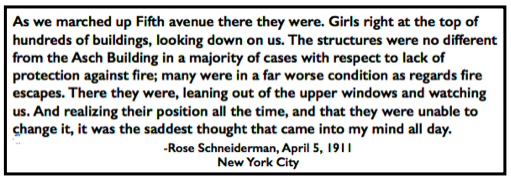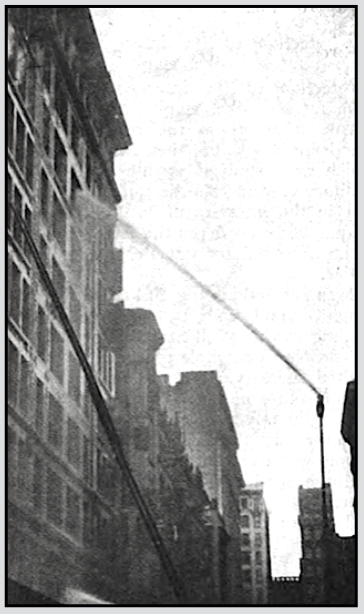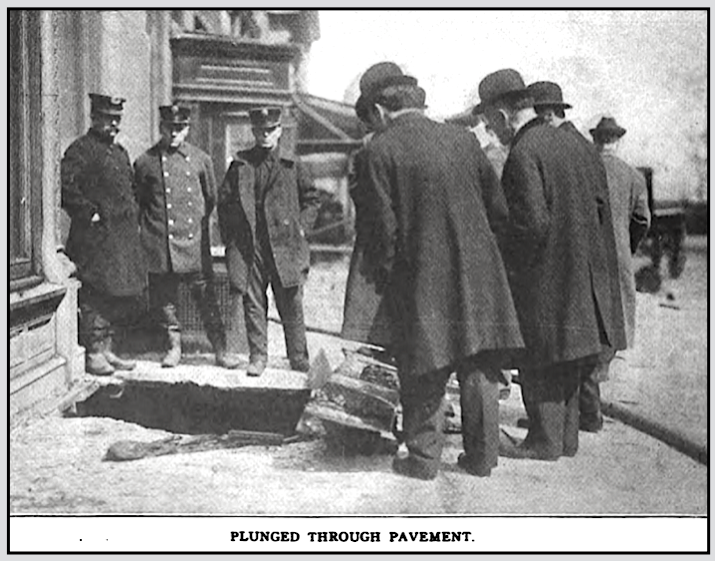 ———-
———-
Hellraisers Journal – Thursday May 4, 1911
Louis Duchez on Murder of Shirtwaist Makers in New York City, Part II
From the International Socialist Review of May 1911:
THE MURDER OF THE SHIRT WAIST MAKERS
IN NEW YORK CITYBY LOUIS DUCHEZ
Photographs by American Press Ass’n.
[Part II of II.]
Violations of the law? Yes, enough to hang half a dozen rich exploiters and politicians. But these men won’t hang.
The owner of the building claimed he lived up to the letter of the law. So did the owners of the shirtwaist concern, Blanck and Harris. They blame the city officials. The State Commission of Labor also blames the city officials. On the other hand, the city officials are hunting for someone to point to. One of these gentlemen divides the guilt between God and the “public conscience.”
The more important facts, however, are as follows: While the holocaust was taking place the superintendent of public buildings, Rudolph P. Miller, was on a pleasure trip to Panama. Under questioning conducted by Fire Marshal Beers he admitted that the Asch building, in which the fire took place, had not been inspected since it was built, ten years ago. He said he was not even sure that he passed on the building before it was occupied. Miller is not an architect; he is simply a civil engineer-with a “pull.” In his testimony he also admitted that he knew of “graft” from building owners being accepted by inspectors. Miller blamed the police department.
According to the state law, “fire-proof” buildings need not put up more than one fire escape. And that’s all the Asch building had. And this one was useless. When the flames heated the flimsy iron work. it bent like wire. Besides, the scaling ladders were not fit to use and the extension ladders reached only to the 6th floor. The hose, too, was rotten, and the fire apparatus was only so in name. Then iron shutters blocked the fire escape, such as it was.
The locked doors have been mentioned. There was no fire escape to the roof. The machines were so closely packed together, in order to save space. that a panic resulted when the fire first started. Large piles of combustible goods obstructed every aisle and opening, also, if the building and conditions had been deliberately planned for the cremation of human beings, it could not have been more perfect.
To look at the Asch building since the fire one could not tell from the outside that anything had happened to it, were it not for the broken windows. As a matter of fact, the damage only reached $5,000. Everything was insured-but the slaves.
It is also stated that both Blanck and Harris were in the building an hour before the fire. Bernstein, the superintendent of the factory and a stockholder, incidentally, was not among those that perished. The junior member of the firm testified that they cleared $1,000,000 in 1908.
A Miss Deutchman, who took part in the shirtwaist strike in 1909 and who worked five months for the Triangle concern, concealing the fact that she was a member of the union, tells the following story of this scab concern:
This is one of the worst shops that I have ever worked in. When applying for work you have to undergo a half hour or more of examination about union affiliations. When a person was hired, after working at a machine, she would again be asked by Mr. Bernstein, a man in charge of the floor, when she or he was a member of the union. One of my friends who was hired about two weeks ago, was asked whether he was a member of the union, and Bernstein asked him to bring the union book to the shop or he could not work there. My friend left the shop and never returned to give up his union book.
In the shop there is always a bunch of people spotting the girls at work. Colored women are employed to look out for the girls. When a girl stays in the toilet longer than the woman thinks she ought to stay there, she is told to get out.
Another girl tells the following story:
About two and a half years ago I went to work for the Triangle Waist Company. At that time there was no talk of organizing the shop. The spy system the firm employed was simply horrible. They could trace every movement of a girl. For walking in the shop the girls would immediately be fired. Although the shop was big and supposed to have enough light, there was no light whatsoever in there.
The machines were kept together in long rows. A girl could not pass between the machines. The girls sat back to back, and if one moved her chair, others could not pass.
At the conclusion of the day’s work girls were searched, like thieves. When a fire engine passed the block and the girls got nervous and excited, they were not allowed to move from their places and go over to the window to see if the fire was in the building. Finding the conditions so bad, I left my job on the fourth day, although I badly needed the money.
Perhaps “public sentiment” in Greater New York has never been so stirred as by this fire. But it will soon blow over. Investigations since the horror have shown that there are more than 10,000 buildings in the city equally as dangerous as was the Asch building. A fire such as took place had been predicted several times since the Newark, N. J., massacre a few weeks ago. It didn’t come as a great surprise. Nor will others that are sure to follow come as a surprise. Just prior to the terrible holocaust there was an organization, known as the “Property Owner’s Protective League,” formed for the purpose of smothering city ordinances detrimental to property owner’s interests and for the purpose of “seeing” inspectors, etc.
There is one big lesson which the fire should teach the workers, and if this lesson is not learned, all the propaganda and investigations and demonstrations will be of little value. That lesson is UNIONISM-strong, aggressive, MILITANT UNIONISM.
The blame for the Triangle slaughter weighs more heavily upon the back of organized labor in New York City than upon all the politicians and inspectors combined. If organized labor in this great metropolis had struck as one man when the girls struggled so desperately in 1909 against the Triangle and other firms, the workers would have controlled this shop and the organized and unorganized would have prevented the recent horror. Where the boss is supreme and where a committee of the workers is not on the look-out, there isn’t the least thought given the lives of the slaves.
There should have been a general strike in the city the Monday following the fire, regardless of what the city heads thought or threatened. Then the masters would have been taught a lesson which they would have long remembered, and this was the sentiment of the rank and file, too.
The Newark girls, after the fire there, went around to the bosses and said they would not work until the factories were made safer, and there was a change. That is what the workers in New York City should do. The secretary-treasurer of the International Ladies’ Garment Workers’ Union, John A. Dyche, had the right idea when he said a day or so after the fire:
Workers should lay down their tools and refuse to work until the fire escapes are installed.
Let us hope that he will put forth strenuous efforts to realize the following statement, which he made about the same time:
I will move that the workers employed in these 180 shops, no matter whether they are under association bosses or under agreements with the union, should lay down their tools and strike for the wiping out of death-trapping shops.
The workers are being driven by every such disaster to look to themselves, to their own organized power to change things. Miss Rose Schneiderman, vice-president of the Women’s Trade Union League, in speaking before the “citizens’ meeting,” engineered by millionaires, preachers and politicians in the Metropolitan Opera House, April 2, in behalf of the fire victims, said that the workers cannot expect to be secure from fires or anything else, for that matter, until the working class has a strong movement which will compel the employers to recognize them. She opened her speech with the following striking paragraph:
Citizens, you have been tried time and again and found wanting. Every time the working people try to protest for their rights, the law says, “Be orderly.” The strong hand of the law beats us back, and back we go to conditions that make our lives unbearable. It would be treachery and treason to those burned bodies if I came here to talk fellowship. Too much blood has been spilled.
The most deplorable thing about it all is that the great masses are ready to act, but the cliques, with their organized machines, are afraid that the movement might get too big for them to control.
But the day is rapidly approaching when the conservative leaders will and must be swept aside. To smother the spontaneity of class feeling is like attempting to smother a volcano.
May that day soon come. However much it may stir up things, it cannot be any worse than the daily slaughter of industrial slaves. The terror which the middle class mind holds toward the Social Revolution is a daily hope to the machine trained mind. The worker welcomes its approach, for he knows instinctively that it brings with it power, intelligence and solidarity. We cannot begin to rehearse the Social Revolution too soon.
—————
[Emphasis added.]
~~~~~~~~~~~~~~~~~~~~~~
SOURCES & IMAGES
Quote Rose Schneiderman, NY Tb p2, Apr 6, 1911
https://chroniclingamerica.loc.gov/lccn/sn83030214/1911-04-06/ed-1/seq-2/
International Socialist Review
(Chicago, Illinois)
-May 1911, page 670
“Murder” by Duchez, Part II
https://www.marxists.org/history/usa/pubs/isr/v11n11-may-1911-ISR-gog-Corn-OCR.pdf
See also:
Hellraisers Journal – Wednesday May 3, 1911
Louis Duchez on Murder of Shirtwaist Makers in New York City, Part I
Tag: Triangle Shirtwaist Factory Fire
https://weneverforget.org/tag/triangle-shirtwaist-factory-fire/
~~~~~~~~~~~~~~~~~~~~~~~~~~~~~~~~~~~~~
The Triangle Shirtwaist Fire Song – Mike Stout


